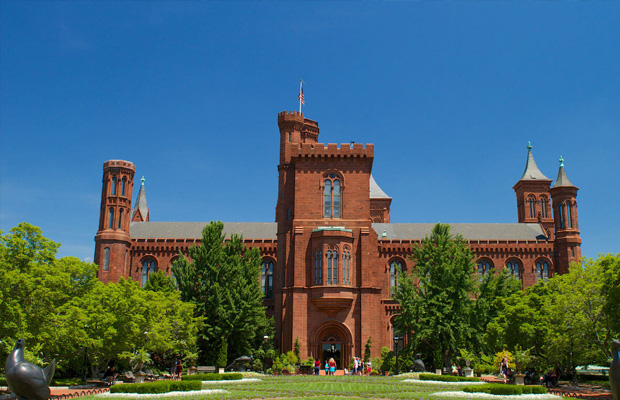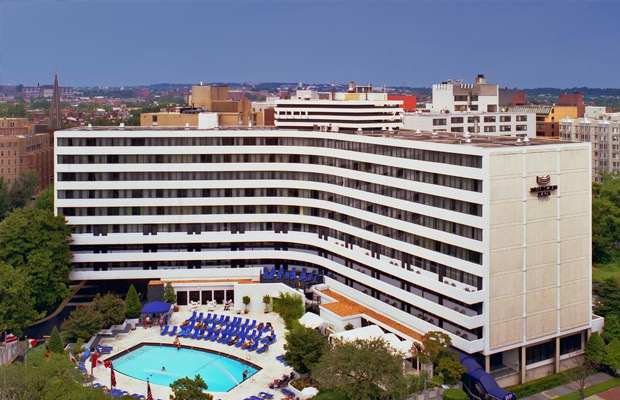Smithsonian Castle
Smithsonian Castle
USA
Washington DC
Washington DC Travel Guide
Book Tour & Activities
Your tour in Washington DC.
Book your stay
Your hotel in Washington DC.
Overview
The Smithsonian Institution Building, located near the National Mall in Washington, D.C. behind the National Museum of African Art and the Sackler Gallery, houses the Smithsonian Institution's administrative offices and information center. The building is constructed of Seneca red sandstone in the Norman Revival style and is nicknamed The Castle. It was completed in 1855 and designated a National Historic Landmark in 1965.
The Smithsonian Institution Building, located near the National Mall in Washington, D.C. behind the National Museum of African Art and the Sackler Gallery, houses the Smithsonian Institution's administrative offices and information center. The building is constructed of Seneca red sandstone in the Norman Revival style and is nicknamed The Castle. It was completed in 1855 and designated a National Historic Landmark in 1965.
History
The Castle was the first Smithsonian building, designed by architect James Renwick, Jr., whose other works include St. Patrick's Cathedral in New York City and the Smithsonian's Renwick Gallery, also in Washington D.C. The building committee held a nationwide design competition in 1846 and selected Renwick's design by a unanimous vote. A cardboard model of Renwick's winning design survives and is on display in the Castle. Renwick was assisted by Robert Mills,[3] particularly in the internal arrangement of the building.
Initially intended to be built in white marble, then in yellow sandstone,[4] the architect and building committee finally settled on Seneca red sandstone from the Seneca Quarry in Montgomery County, Maryland. The redstone was substantially less expensive than granite or marble, and while initially easy to work, was found to harden to a satisfactory degree on exposure to the elements.[5] Scholarly evidence indicates it is likely that slaves were employed at Seneca in quarrying stone for the Castle, though no evidence has surfaced that slaves were involved in the actual Castle construction.[6]
The building committee selected Gilbert Cameron as the general contractor, and construction began in 1847. The East Wing was completed in 1849 and occupied by Secretary Joseph Henry and his family. The West Wing was completed later the same year. A structural collapse in 1850 of partly completed work raised questions of workmanship and resulted in a change to fireproof construction. The Castle's exterior was completed in 1852; Renwick's work was completed and he withdrew from further participation. Cameron continued the interior work, which he completed in 1855.[3] Construction funds came from "accrued interest on the Smithson bequest."
Despite the upgraded fireproof construction, a fire in 1865 caused extensive damage to the upper floor of the building, destroying the correspondence of James Smithson, Henry's papers, two hundred oil paintings of American Indians by John Mix Stanley, the Regent's Room and the lecture hall, and the contents of the public libraries of Alexandria, Virginia and Beaufort, South Carolina, confiscated by Union forces during the American Civil War. The ensuing renovation was undertaken by local Washington architect Adolf Cluss in 1865-67. Further fireproofing work ensued in 1883, also by Cluss, who by this time had designed the neighboring Arts and Industries Building. A third and fourth floor were added to the East Wing, and a third floor to the West Wing. Electric lighting was installed in 1895.
Around 1900, the wooden floor of the Great Hall was replaced with terrazzo and a Children's Museum was installed near the south entrance. A tunnel connected to the Arts and Industries Building. A general renovation took place in 1968-70 to install modern electrical systems, elevators and heating, ventilation and air conditioning systems.[3] The Enid A. Haupt Garden was dedicated in 1987, along with the Renwick Gate facing Independence Avenue, built from Seneca redstone retrieved from the demolished D.C. Jail.
Located in: National Mall
Address: 1000 Jefferson Dr SW, Washington, DC 20560, United States
Construction started: 1849
Opened: 1855
Architectural styles: Victorian architecture, MORE
Architect: James Renwick Jr.
Video Travel Inspiration
See Smithsonian Castle on Map
Most Popular Cities

Siem Reap
Cambodia
Ho Chi Minh City
Vietnam
Beijing
China
Paris
France
London
United Kingdom
New York
USA
Tokyo
Japan
Bangkok
Thailand
Seoul
South Korea
Vientiane
Laos
Yangon
Myanmar
Washington DC
USA
Los Angeles
USA
Ottawa
Canada
New Delhi
India
Singapore
Singapore
Kuala Lumpur
Malaysia
 English
English French
French Khmer
Khmer Thai
Thai Vietnamese
Vietnamese Chinese
Chinese Korean
Korean German
German Japanese
Japanese Italian
Italian Russian
Russian Spanish
Spanish Dutch
Dutch Indonesian
Indonesian Malay
Malay





































